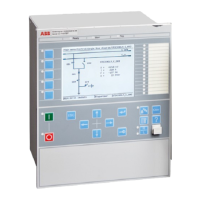Manual configuration of VCTR GOOSE data set is required. Note that both data
value attributes and quality attributes have to be mapped. The following data
objects must be configured:
• BusV
• LodAIm
• LodARe
• PosRel
• SetV
• VCTRStatus
• X2
The transformers controlled in parallel with the circulating current method or the master-
follower method must be assigned unique identities. These identities are entered as a setting
in each TR8ATCC, and they are predefined as T1, T2, T3,..., T8 (transformers 1 to 8). In figure
160 there are three transformers with the parameter
TrfId
set to
T1, T2
and
T3
, respectively.
For parallel control with the circulating current method or the master-follower method
alternatively, the same type of data set as described above, must be exchanged between two
TR8ATCC. To achieve this, each TR8ATCC is transmitting its own data set on the output
ATCCOUT as previously mentioned. To receive data from the other transformers in the parallel
group, the output ATCCOUT from each transformer must be connected (via GOOSE or
internally in the application configuration) to the inputs HORIZx (x = identifier for the other
transformers in the parallel group) on TR8ATCC function block. Apart from this, there is also a
setting in each TR8ATCC =/,..., =/
T1RXOP=Off/On,..., T8RXOP=Off/ On
. This setting
determines from which of the other transformer individuals that data shall be received.
Settings in the three TR8ATCC blocks for the transformers in figure
160, would then be
according to the table 32:
Table 32: Setting of TxRXOP
TrfId=T1 T1RXOP=
Off
T2RXOP=
On
T3RXOP=
On
T4RXOP=
Off
T5RXOP=
Off
T6RXOP=
Off
T7RXOP=
Off
T8RXOP=
Off
TrfId=T2 T1RXOP=
On
T2RXOP=
Off
T3RXOP=
On
T4RXOP=
Off
T5RXOP=
Off
T6RXOP=
Off
T7RXOP=
Off
T8RXOP=
Off
TrfId=T3 T1RXOP=
On
T2RXOP=
On
T3RXOP=
Off
T4RXOP=
Off
T5RXOP=
Off
T6RXOP=
Off
T7RXOP=
Off
T8RXOP=
Off
Observe that this parameter must be set to
Off
for the “own” transformer. (for transformer
with identity T1 parameter
T1RXOP
must be set to
Off
, and so on.
Blocking
SEMOD159053-275 v2
Blocking conditions
SEMOD159053-277 v6
The purpose of blocking is to prevent the tap changer from operating under conditions that
can damage it, or otherwise when the conditions are such that power system related limits
would be exceeded or when, for example the conditions for automatic control are not met.
For the Automatic voltage control for tap changer function, TR1ATCC for single control and
TR8ATCC for parallel control, three types of blocking are used:
Partial Block: Prevents operation of the tap changer only in one direction (only URAISE or
ULOWER command is blocked) in manual and automatic control mode.
Auto Block: Prevents automatic voltage regulation, but the tap changer can still be controlled
manually.
1MRK 511 358-UEN A Section 13
Control
315
Application manual

